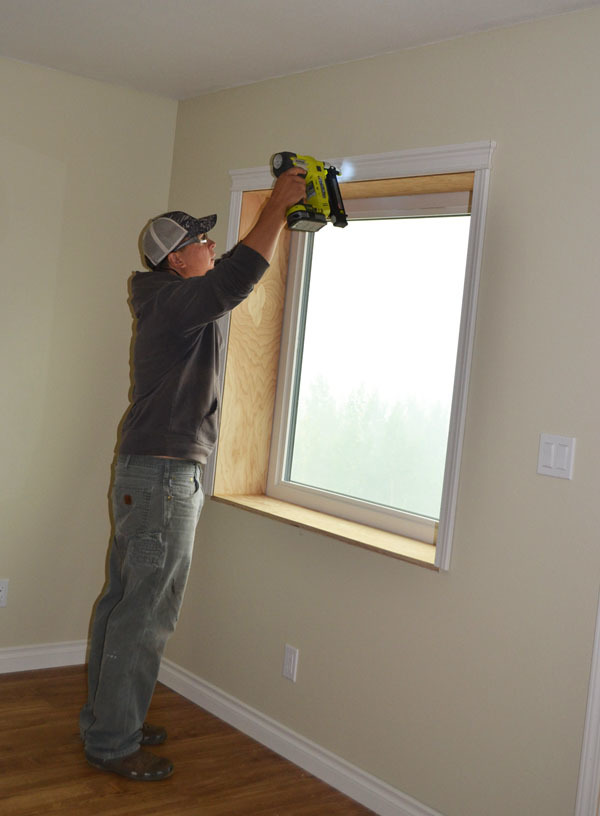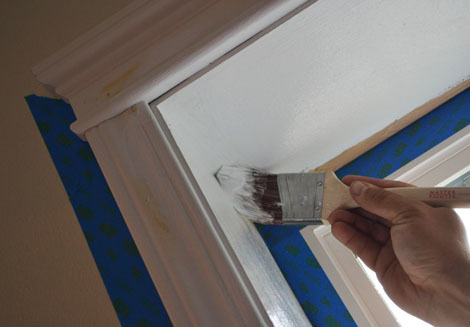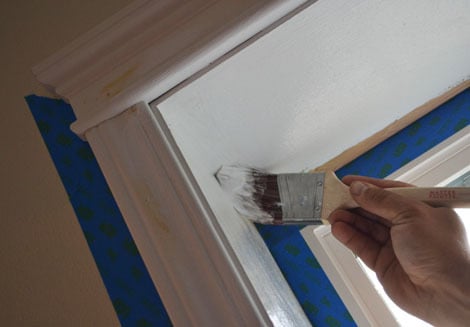Paint all of the trim in the house.
Every single piece.
Every single doorway.
Every single closet opening.
Every single piece of base moulding.
Every single window sill.
That's what we've been up to.

Jealous much?
This is what the Momplex, Unit B, built just for Mom who likes to sew (the Ram's Mom) has looked like for the past couple of weeks.
I'll spare you a photo of what we look like. The good news is paint does eventually come out of your hair. Eventually.
It sure is easier to cut a piece of trim and nail it up, isn't it? Painting really is the tough part!
To make things easier, we decided to whenever possible, paint whatever we can on the ground as opposed to on a ladder over our head ... or even worse, on our knees, in a corner of a closet, painting baseboard.
So first up, we created a conviently located painting spot for pre-painting trim.

Our friends at 3M DIY knew we were about to take on a monster painting project, so they sent us a little care package to make things easier on us, including this heavy duty non slip paint drop cloth.

We spread the drop cloth down on the floor - it's got a special webbing, kinda like drawer liner, so it stays where you put it. It's also waterproof, so no nagging feeling, wondering whether or not the paint drips are going to soak through.

And then we painted as much of the trim as we possibly could over the drop cloth. These are the headers for the windows and doorways. It was definitely easier to paint 30 of these guys over a drop cloth, instead of on a ladder over our heads!

While the headers were drying, I got to work on the windows jambs. The plywood we used was already sanded, but I took a second to fill any cracks or knots with wood filller.

Then I sanded the wood, starting with a medium grit sandpaper, and working my way down to fine grit. The window felt smooth and splinter free when I was done sanding it.

To prepare for painting, I then cleaned the windows with a vacuum ..... I swear I didn't try to coordinate my beloved hearing protection with my outfit. For me, even running a vacuum, I protect my hearing.

Once the window is cleaned, I taped it off with painter's tape.
MORE INFORMATION: ScotchBlue Painter's Tape

On the inside of the window to protect the actual window from getting painted. This only took a few minutes per window.

Then we nailed up those prepainted headers and aprons.
Which left us with ugly nail holes in all the trim.
Nothing a little wood filler can't fix! I love the 3M wood filler from our care package because it doesn't shrink as much when it dries and it's easy to sand excess off.
Grace and I went around and filled all the holes with wood filler, overfilling slightly.
And then let the wood filler dry.
MORE INFORMATION: 3M Advanced Abrasives
Then we sanded any excess wood filler off the top with a small piece of medium sandpaper.

Almost ready for paint ... almost.
Then taped off the outsides of the casing on all the doors and windows since we put the casing up already (it's easy to paint in place).

And finally, we are ready for paint!
Since our window jambs are so wide, we used a roller to roll primer on the bare wood.

But we still had to touch up the corners with a good ole paint brush.

Having the window taped off really saved us a ton of time - especially since we've got a primer coat and then three coats of paint to apply.

To each and every window.





Comments
karahart
Tue, 09/03/2013 - 17:33
Amazing
Tsu Dho Nimh
Wed, 09/04/2013 - 03:31
Oh wow!
spiceylg
Wed, 09/04/2013 - 04:37
Yikes
purejuice
Wed, 09/04/2013 - 10:40
amazing how much elegance the
Susan P
Wed, 09/04/2013 - 20:38
Mom Plex
In reply to Mom Plex by Susan P
spiceylg
Thu, 09/05/2013 - 05:23
Kitchen
Cathy B
Mon, 09/09/2013 - 22:54
pre-painting the trip